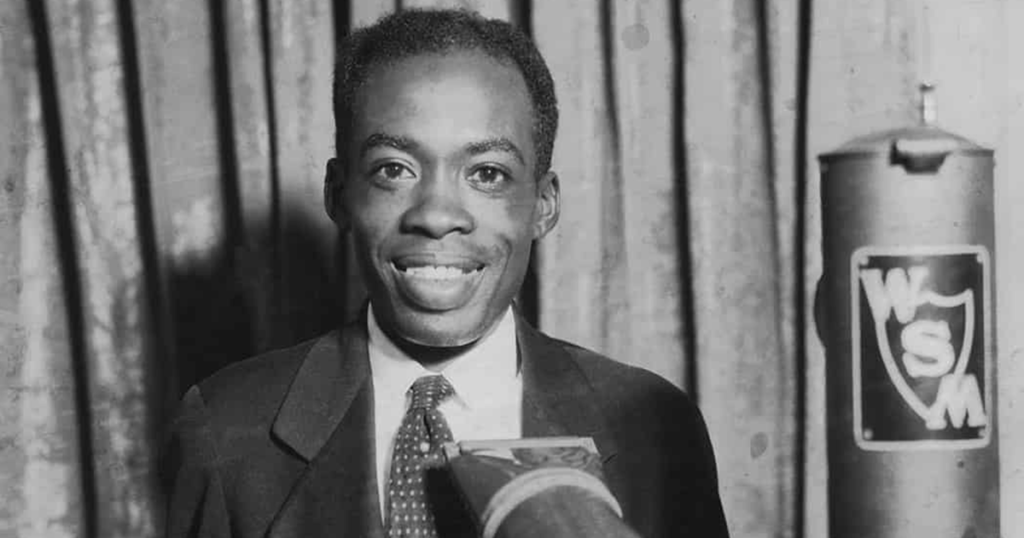Artist Spotlight: DeFord Bailey

DeFord Bailey
DeFord Bailey, born in Smith County, Tennessee, on December 14, 1899, was a prominent American country music and blues star. He was one of the first African-American performers in country music and the first to appear at the Grand Ole Opry, one of America’s most popular live country music shows.
Bailey was born into a family with a rich musical heritage. His father played the banjo, and his mother played the harmonica. However, when he was just a child, Bailey was stricken with polio. While this disease left him with a lifelong disability, it was during his recovery that he began to play the harmonica, mimicking the sounds he heard around him, from the whistles of the local trains to the rushing waters of the Cumberland River.
Despite his physical limitations, Bailey’s exceptional musical skills quickly became apparent. His style was heavily influenced by the sounds of nature, the rhythms of the railroad, and the blues and spiritual music of his African-American heritage. He was renowned for his virtuosic ‘fox chases’, instrumental pieces imitating the calls and sounds of a fox hunt, and his unique blending of blues and country music.
DeFord Bailey was a pioneering figure in the world of country music, one of the first African-American performers in the genre, and the first to play on the Grand Ole Opry. However, as an African-American man in the early to mid-20th century American South, his career was marked by numerous racial struggles and barriers.
One of the most significant challenges Bailey faced was the racial segregation and discrimination prevalent during the era. As an African-American, Bailey was not allowed to share accommodations with white performers while on tour or even eat in the same restaurants. This segregation was a harsh reality for many black musicians of the time, and despite Bailey’s growing fame, he was not exempt.
The racial prejudice extended beyond these personal indignities. It influenced the way the music industry worked and how Bailey’s career developed. Although Bailey was a regular performer on the Grand Ole Opry, his appearances were often uncredited. His performances were considered “filler” and were not even included in the official Opry program. This was a reflection of the systemic racism that minimized the contributions of black artists and undermined their success.
In 1925, Bailey made his debut performance on the Grand Ole Opry, an important platform for budding country musicians. He played his popular “Pan American Blues” on the harmonica, a tune inspired by the sound of the Pan American, a Louisville & Nashville Railroad passenger train. His performance was so successful that it essentially secured him a regular slot on the show.
Perhaps most striking was Bailey’s departure from the Grand Ole Opry in 1941. The reasons for this are still a matter of debate, but one popular account suggests that the Opry’s management decided to let Bailey go after an argument over licensing rights. The Opry management was reportedly uncomfortable with the level of success and influence Bailey was gaining and used the disagreement as an excuse to dismiss him.
Bailey’s post-Opry career is also indicative of the racial barriers he faced. Despite being one of the most talented harmonica players of his time, Bailey was not able to sustain a career in music after leaving the Opry. Instead, he spent the remainder of his life working in Nashville as a shoeshine man, largely forgotten by the music industry until a resurgence of interest in his work in the 1970s.
In 2005, almost 23 years after his death in 1982, DeFord Bailey was posthumously inducted into the Country Music Hall of Fame, finally receiving recognition for his remarkable influence on the genre. His story serves as a potent reminder of the often-underappreciated role of African-American musicians in shaping country music.
Bailey’s musical legacy remains in the unique sonic bridge he built between blues and country music. His virtuosity and inventiveness on the harmonica have inspired generations of musicians, and his recordings continue to be a testament to his talent. DeFord Bailey’s music and life are a testament to resilience, creativity, and the power of music to transcend boundaries.
Works
DeFord Bailey didn’t create albums in the modern sense. Much of his work was not formally recorded or released during his lifetime. However, several compilations of his work have been released posthumously. Here are some of them:
- “The Legendary DeFord Bailey: Country Music’s First Black Star” (1998): This compilation includes a range of Bailey’s tunes, from his signature “Pan American Blues” to “John Henry,” a classic folk song. This release provides a great overview of Bailey’s groundbreaking harmonica playing style.
- “DeFord Bailey: A Black Star in Early Country Music” (1991): Released in tandem with a book of the same title, this album features recordings of Bailey’s live performances and gives listeners a sense of his on-stage prowess. It includes both his signature train imitation songs and his renditions of popular country tunes.
- “Harmonica Blues: Old-Time Country Harmonica” (1997): While not exclusively featuring DeFord Bailey, this album includes several of his tracks among a selection of harmonica-based blues and country tunes from the 1920s and 30s. It showcases his music in the context of his contemporaries, highlighting his influence on the genre.
These compilations, while sparse, offer a glimpse into Bailey’s considerable talent and his innovative approach to the harmonica. It’s worth noting that Bailey’s influence is not limited to these posthumous releases; his style of harmonica playing shaped the sounds of country and blues music and inspired many musicians who followed in his footsteps.




